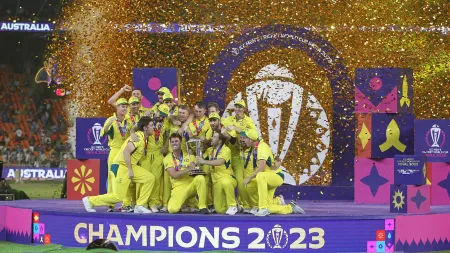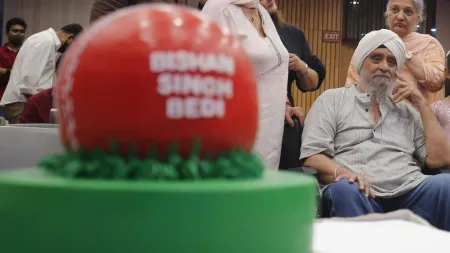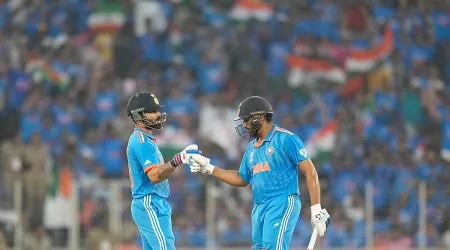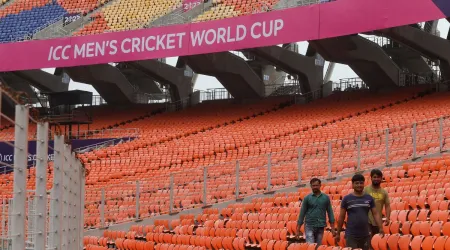- India
- International
Luka Modric and Croatia seal third-place finish in his last World Cup game
The narrative of 2018 world cup finalist Croatia's football is imperceptibly inter-twined with their politics, identity and nationalism.
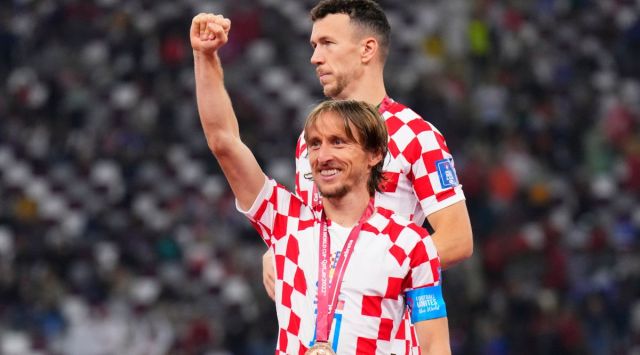 Croatia's Luka Modric celebrates with his medal after the World Cup third-place playoff soccer match between Croatia and Morocco at Khalifa International Stadium in Doha, Qatar, Saturday, Dec. 17, 2022. Croatia won 2-1. (AP)
Croatia's Luka Modric celebrates with his medal after the World Cup third-place playoff soccer match between Croatia and Morocco at Khalifa International Stadium in Doha, Qatar, Saturday, Dec. 17, 2022. Croatia won 2-1. (AP)Luka Modric couldn’t stop smiling and flicking his sweaty hair back at the end of his last world cup game. He would pump his fist, throw his head back, look up to the skies and slowly shut his eyes when the final whistle blew to seal Croatia’s third place finish at the world cup. His kids would join him after the team’s photo op and he would lean over to hug him.
Two days before the world cup began, he had posted an image of himself in the team jersey, hands stretched out, and with the note: We are ready. It’s been some journey for him, and his nation, to finish runners-up in the last world cup and now, at the third place.
Along a curve on a narrow winding road that slopes up to the Velebit mountain range, one of the two pathways that connected north and south of Croatia before a new highway came up in the last decade, there was a lone house where Luka Modric lived till he was six. One day in 1991, when his grandfather, also named Luka, went up the hill with his cattle, he was shot dead by local Serbian rebels.
We are ready 🇭🇷🙏 pic.twitter.com/LU6oVh6HJU
— Luka Modrić (@lukamodric10) November 20, 2022
The Yugoslav Civil War had exploded into the lives of the Lukas, who lived in the rural settlement of Modrici. The family moved to a refugee camp where the boy would kick around a paper ball. Soon, they shifted to the city of Zadar, and lived in a hotel for a few years. Zadar would be peppered by grenades from surrounding hills but once it abated, Modric would kick around with the ball again.
Around the same time, Ivan Rakitic was taken to Switzerland by his family who feared the civil war would endanger the lives of kids. The current Croatian team has stories of players who grew up in the shadow of conflict, which came to be known as the ‘Homeland War’. After the allied victory in the World War II, Yugoslavia was set up as a federation of six republics along ethnic and historical lines. After the Civil War in the 1990’s, it splintered into seven independent entities: Serbia, Croatia, Macedonia, Montenegro, Slovenia, Bosnia & Herzegovina, and Kosovo.
Football played a huge part in the shaping ethnic identities which led to disintegration of Yugoslavia and the activities of football fans during the civil war remains one of the most prominent examples of the extent to which football and nationalist politics synced. In Croatia, the fans of the most prominent club Dinamo Zagreb were the first to volunteer for the war. Similar scenes played out in Serbian Belgrade and elsewhere.

Things came to head on 13 May 1990. A riot broke out at the Maksmir stadium in Zagreb, a Croatian region, during a match between Dinamo Zagreb and Red Star Belgrade. The game was abandoned as fans from both sides invaded the pitch and clashed; around 60 people were seriously wounded. Many Croatians and Serbians see that day as the start of the civil war. It threw up the famous imagery of Dinamo’s footballer Zvonir Boban kicking the security forces, perceived as sympathetic to Serbs. It was called the kick that started the war.
The kick that started a war.
Zvonimir Boban,
Red Star vs Dinamo, 13th May 1990. pic.twitter.com/V8mYJiTfYe— Ian Reynolds (@Ian_Reynolds87) May 13, 2021
“Not quite accurate that it was the start of the war but it has a huge symbolic moment among nationalist Croatians,” Dario Brentin, researcher at Centre of Southeast European studies at University of Graz, told The Indian Express. “A year later, in May 1991, they were still playing each other in the Yugoslavian league—that’s why I say the 1990 incident wasn’t the start but I can understand why people perceive it to be. By the time war started in the early summer of 91, it was important for the Croatian national narrative to have this possibility of togetherness in the combined Yugoslav state. The Maksmir incident becomes part of folklore as a strong symbolic statement.”
Football nights at the Bernabéu 🟡🤝 pic.twitter.com/ptwMy2KqWt
— Luka Modrić (@lukamodric10) October 23, 2022
The disintegration started in the early 80’s in the unified Yugoslavia: Increase in unemployment, hyper-inflation, rise of ethnic identities. “It’s in this context that organised football fandom started to emerge, mirroring what was going on in Italy, England, and parts of Western Europe. They were from largely urban centres like Zagreb, Belgrade, Saravejo, and they were articulating their political views loudly in the stadium,” said Brentin.
“The stadium in the late 80s and early 90s became more or less an arena of national hatred. Because there are little ways of sanctioning such large groups of people. So you have an open nationalism or anti-Yugoslav sentiments flowing in the stands. In that context Maksimir 1990 happened.” Zeliko Raznatovic, known as Arkan, a future war criminal who started his notorious football club in future, led the ultras from Red Star known as Delije (Heroes), and clashed with Bad Blue Boys.
President scores a goal
The Maksmir riots would be used for political recognition by Croatia president, Franjo Tudman. In the 60’s, Tudman was the head of the popular Partizans club, and was intimate with the power of football over the masses, and once famously said: “Football victories shape a nation’s identity as much as wars do”.
In his 10-year presidency, he put football at the forefront to galvanise the Croats. “He was the reason why politicisation of sport happened better in Croatia than Serbia. Serbia’s Slobodan Milosevic was a bureaucrat who wasn’t interested in sports whereas Tudman knew what sport could do politically for him and the country,”says Brentin.
So, he got hands-on in running the clubs, pumped in money, emotionally played the populace, and barring one instance – when he tried to change the name of Dinamo Zagreb as Dinamo was too Bolshevic and brought socialist Yugoslav memory, but was fiercely opposed by the Bad Blue Boys. He changed it but after he succumbed to cancer, the name was reverted. Even the president can’t mess with the football fans in Croatia. “BBB formulated their own ideological standpoint as Croatian nationalists,” Brentin explained.
“They were among the first ones to volunteer to go to war. They saw themselves betrayed. For them Dinamo, despite its socialist connotation, was a connotation of Croatian nationalism. Back in the Yugoslav days, when people said they were Dinamo fans, it was clear where they stood politically,” he added.
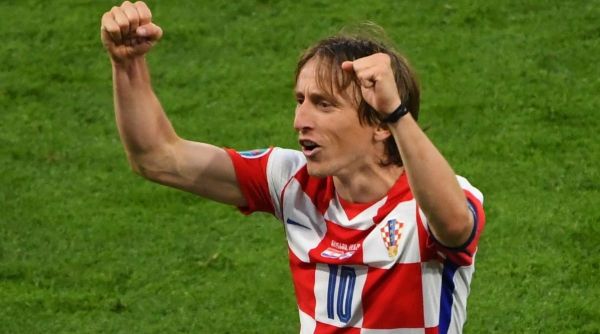 Croatia’s Luka Modric. (REUTERS/Andy Buchanan)
Croatia’s Luka Modric. (REUTERS/Andy Buchanan)
Modric first joined Dinamo. But he was soon loaned out to Inter Zapresic, a Bosnian club, where his career took off. Rakitic chose to play for Croatia, angering the Swiss fans as they felt he owed it to them, but he didn’t flinch. He went to Seville before moving to Barcelona.
In Seville he met his wife – a sweet story in itself. He was sitting with his brother at the hotel bar, a day before he was to sign for Seville, when he was mesmerised by the waitress. The brother got a call from another European club who were willing to fly him right away but in Rakitic’s telling, it was the sighting of the lady that made up his mind. After months of relentless efforts, she agreed to go out with him, and they eventually married.
Meanwhile, Croatian football was still going through cathartic moments. In 2013, national player Josip Šimunic grabbed the microphone in front of 25,000 people at the Maksimir stadium, and shouted, “Za dom” (for the home land). The stands reverberated: “Spremni” (ready). Spremni is considered a fascist salute, harking back to pre-WWII days.
Furore in the stands
Josip’s move kicked up a furore and Brentin explains the reason: “Croatian nationalism is fairly self-referential. Through the early 2000’s, there was a ritual fan practice during national games: They would chant Za dom, Spremni after every game. It was the official fascist salute of the independent state of Croatia from WWII, but in Croatian society there is no consensus of the meaning of Za dom. There is a 50-50 split: on the left, people see it as a fascist salute. On the right, people say it may be a fascist salute but it predates the war and that it’s an old Croatian greeting. As for Josip, he is from the Australian diaspora and the Croatian diaspora community is quite conservative. For him, Yugoslavia was the worst evil that existed. He and a lot of people had a different understanding of what the chant meant than what a leftist or a liberal intellectual would have.”
Ahead of the world cup in Russia in 2018, Croatian football was mired in problems with the clubs’ questionable finances being investigated. There was disillusionment even about the national team but it would be dispelled when they reached the final.
“Croatia was hit severely by the economic downturn of 2008 and has not recovered. It’s witnessing an immense brain drain— people are leaving in really big numbers ever since Croatia joined EU. It’s a national demographic crisis. I would compare it with 1998, when the country was in bad shape—people were unhappy, there was isolation from Europe, the economy was down and then France 98 happened. A national euphoria erupted, and for a little while politics was on the side. In Russia 2018, a similar positive upsurge can kick in to lift the mood of the entire country.” And it did.
Such is the identification with the sport in the country. It defines to the people what it means to be a Croatian.


















